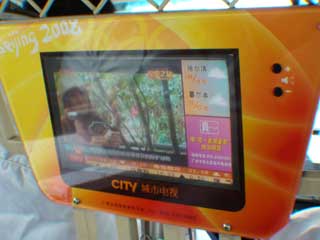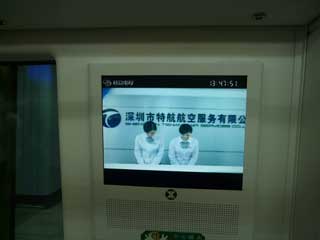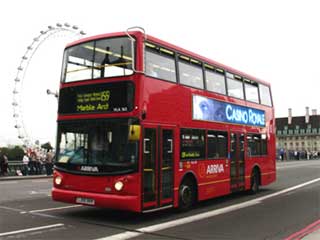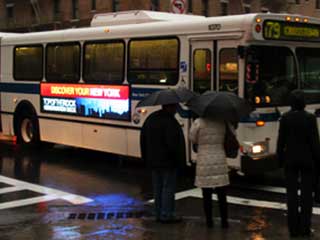Displays in digital transport advertising
Advertising history spans the long way from public criers to… Well, it’s not easy to complete this phrase. Today, advertising is an enormous industry. As air, advertising filled all available space both physical and virtual. Our personal space (my house is my fortress) has long surrendered to TV and Internet advertising. The public space (streets and squares of our cities) are practically saturated with outdoor advertising. Transport resisted the onslaught of advertising longer. But no longer. Advertising has won.
Advertising in transport started as unassuming stickers on the doors and windows of busses and metro carriages. However this could not satisfy demanding advertisers for long. Quite soon digital advertising enters the field: informational and advertising LED signs with running letters and LCD displays. This approach is more professional, based on high-tech solutions, requires large investment but is seriously more effective due to massive audience coverage.
Today we propose to discuss several approaches to managing and controlling digital transport advertising.
Broadcasting is most obvious but an extremely hard method to implement. However, this is the method that is widely used in modern China. It all started with a tiny company that selected a dynamically developing city of Shenzhen as its HQs. In three years Vision China Media n mushroomed to 23 other cities and expanded its transit network (busses and metro) to 121 000 LCD displays. Recently Vision China Media started trading in Nasdaq. The advertising of Vision China is based on broadcasting a TV signal from local TV stations to all busses within the active signal range. The company claims that its daily audience reaches 40 million people which is hardly an overstatement considering the total population of China.
 |
 |
| Informational and advertising LCD display in Guangzhou city taxis | Informational and advertising LCD display in metro |
A similar method was adopted by a large TV and advertising company in the capital of Guandong province: Guangzhou Pearl River City TV. www.gzcitytv.com The novelty of their approach is that apart from the fleet of 5 000 busses (one may guess the average audience easily) the company broadcasts to 11 thousand of local taxi cabs (out of the total fleet of 17 000) and most of public buildings in the city. Thus, the daily coverage is reported as 1 million people, the amount that reminds one of the TV audience for prime time shows.
Both companies have a hard time proving the audience coverage, though. While the total number of passengers in metro can be verified easily, the absence or feedback from LCD displays in taxis and busses turns into a potential and insurmountable problem. A client paying for the package is unable to verify how many taxis and busses were in fact working at any particular day and in how many of those the LCD displays were in fact working. Nonetheless, a fast growth of transit broadcasting in China proves that the method is popular and effective.
Another approach we witnessed in the USA where the largest North American transit advertising company Titan Outdoor started experimenting with digital advertising on the sides of busses. For this purpose, a 12 mm pitch LED sign is installed where we are used to see commercial stickers. In spite of the relatively small resolution the LED sign allows to display advertising texts, slogans, brandnames and logos, as well as simplified videos for all pedestrians and passing cars to see. Having started with 100 busses in downtown Chicago and having received excellent results, the company expanded its operation to Seattle and New York. A similar program was initiated by another company in Vancouver and London.
 |
 |
| LED signs on city busses Photo credit: Titan Outdoor |
|
The advertising method of Titan Outdoor is unique and has an important advantage over the Chinese broadcasting method: the operator has a real-time report of all clips actually displayed. This is achieved by using a smart control system for the network. Another important innovation by Titan is the GPS-linkage between advertising and bus route. The clips are location-linked and as the bus passes through a certain area on its way, the local advertising starts. This makes ads really useful and well-targeted. The low resolution of LED signs is the only disappointment. However the company talks of replacing the existing LED signs with new ones with pitch of 8 or even 6 mm which will instantly improve the quality of advertising clips.
Our comparison brings us to a curious conclusion: China created first large outdoor digital networks where advertising plays a secondary role. Up to 40-50% of all time is given to social information and news blocks. Paradoxically, this only increases the efficiency of advertising since people are not antagonized by the obtrusive advertising. The Chinese digital networks technologically are not the most advanced however the content there is well structured and well-thought. The technologically impeccable digital networks of Titan Outdoor are paying far less attention to content structure compared to their Chinese counterparts.
Whatever method is selected for controlling and managing digital networks for public transport it’s clear that soon all public transport will be sporting advertising displays of all sorts and the public will start getting a dose of the advertising brainwashing while in transit.





